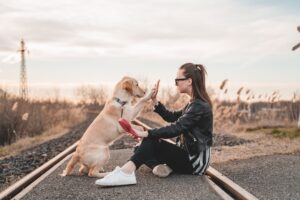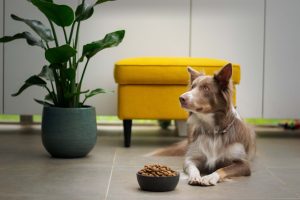Did you know about my FREE support group for Reactive Dog Behaviour?
How dogs learn new behaviours
Ever wondered how your pup learns new (good or bad) behaviours? How can he be great for one person and not another? Why is timing so important? And how it is that you can spend ages teaching him a recall in class and then he can’t do it in the park? Once you figure out the process, everything becomes clearer. So here’s my guide to how dogs learn new behaviours…
Step One…
We’ll use a basic sit as an example, but the process is the same, no matter what kind of trick or behaviour you are working on.
So imagine you’re a puppy and you’re having a fab time mucking about in the garden. All of a sudden your favourite hooman crouches down in front of you with a yummy treat in his hand. You are very interested in the treat, and don’t want to miss out, so you rush over. The hooman speaks but you don’t understand “hooman” so you concentrate on the treat. After a few moments you manage to get the treat out of his hand and he speaks excitedly!
Another treat appears! You really want it, but there was a lot going on. So the big question is, what did you do to get the treat last time?
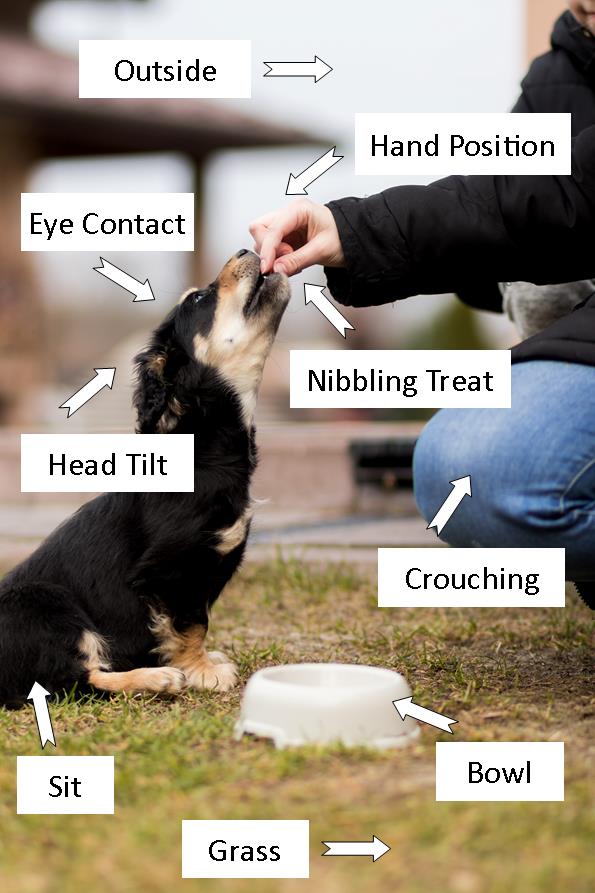
The first time you got the treat you were doing a lot of different things? You were:
- Looking Up
- Outside
- Sitting
- You on the grass
- Nose in the air
- Nibbling a treat
Your favourite hooman was doing a lot too. He was crouching, speaking and holding the treat in his hand. There is no way to know what this hooman wants. So, in order to figure out the “sit” you’ll have to try again.
Figuring it out…
Over the next lot of attempts you have tried different things and the hooman has done some different things too. Some elements have remained consistent, and the ones that weren’t got dismissed. So, as you narrow it down, you are starting to get a bit of an idea of how to get the yummy treats! And you are left doing this for your favorite hooman…
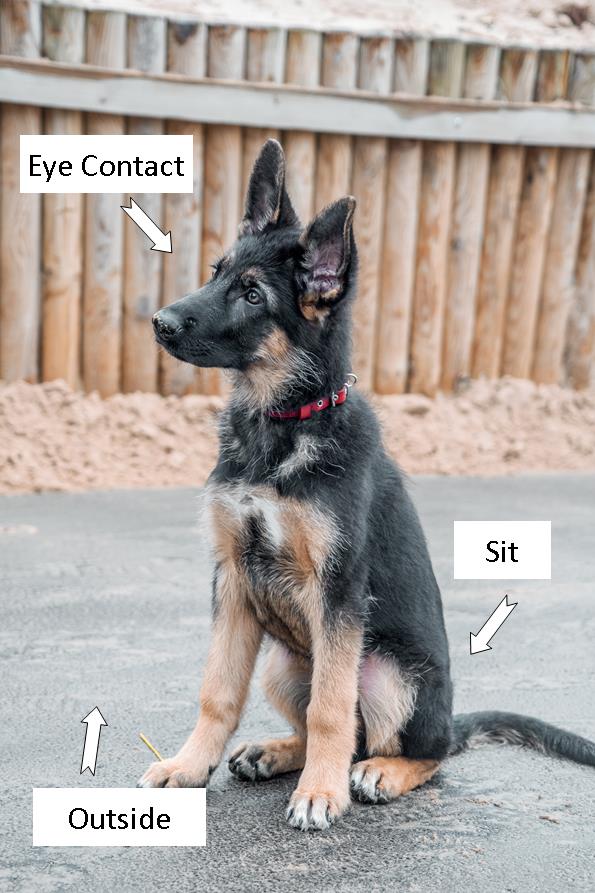
You’ve got it narrowed down to that hooman, a word, the sit position, with eye contact, outside! You confidently repeat the combination but, uh oh, no treat! That’s odd, you must have got it wrong so you stand up and “bingo” the treat arrives! That’s confusing, you thought you had this sit-thing figured out. Better start again!
So what happened?
The hooman was just a bit slow at offering the treat this time, and by the time the pup got it, he was doing something different. Had the treat arrived a bit quicker, it would have reinforced the pups thoughts and the “sit” would have got better. In this case, they’ll have some more practising to do to undo the confusion and catch-up again.
Be very careful when offering the “aw you tried, have the treat anyway” treat! Who knows what you’ll be rewarding at that stage and which element he might dismiss from the combination! If your timing is off, or you give too many sympathy treats, your pup might think this is a sit…
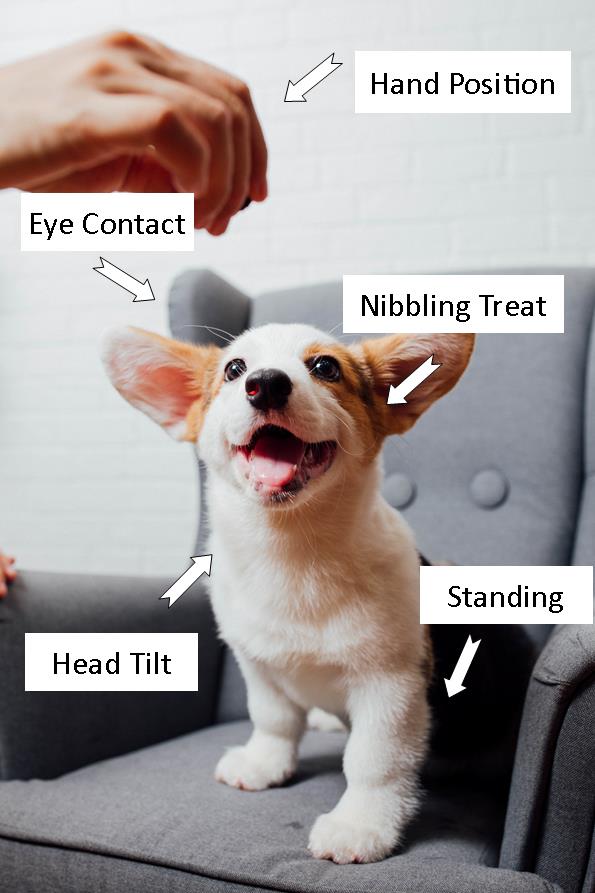
Location, location, location…
It’s likely that when you start training you’ll begin in the house or garden. As your pup narrows down the “sit,” the location isn’t likely to change, so this will remain a key element of the trick. So once your pup is really good at the sit in the first location, you’ll have to teach him again when you go somewhere new. If you’ve done a good job, he’ll figure it out pretty quickly. But, if he wasn’t sure, you can see how he’ll find this a challenge.
You might need to repeat this process a few times, in different places, but eventually he’ll learn that location isn’t part of the “sit”.
The same can happen if only one person focusses on the training. The more people that work on a behaviour, the less likely he’ll associate the new behaviour with just one or two people.
Still not sure?
This is a brilliant (and hilarious) demonstration of how dogs learn through trial and error. We offer a treat (a point), but often we don’t communicate very clearly what we want so our dogs try a bunch of stuff and when they get it right they get the reward (point). But just because they managed to succeed once, they still often have no idea what they did right. It’ll take many more repetitions before they narrow the right behaviour down to something they can reliable reproduce to get the reward. Now imagine, if we aren’t very consistent, or quick to offer the reward? How much harder would it have been for the taskmaster team to figure out that touching their heads got them points if the guy with the scoring machine had been slow to update the total?
Handling distractions
Distractions won’t affect whether he actually understands a command or not, but they will get in the way of him doing it. So, make a list of distractions and practise, practise, practise near those too.
It works both ways
The process of how dogs learn new behaviours is the same, no matter what you are working on. Whether it’s teaching commands like sit, learning to recall, peeing in the house, or barking out the window – it goes like this…
Dog does something – Dog gets something good – dog wonders what caused it – dog repeats combinations until he finds the consistent element – dog does it more and more!
Be careful though, he’ll learn things you don’t want him to do just as easily as the stuff you do. Let’s look at the jumping up behaviour! Human makes eye contact, touches, and talks to the dog – dog loves your attention and wonders what caused it – dogs repeats combinations until he figures out that jumping up was the trigger – dog does it more and more! He really likes getting attention, and if he’s a terrier or a bully breed, he probably likes getting pushed away too!
It doesn’t have to be an obvious reward to reinforce a behaviour, he likes feeling good too. Scaring away the postman, chasing dogs in the park, and relieving a full bladder also make him feel good!
What are you working on?
If your dog persistently performs a behaviour then you can be sure he’s getting something good out of it. If it’s a behaviour you don’t want, then all you have to do is figure out what that reward is, and change the situation so that he feels that same good feeling doing what you want instead. For example, offering a treat when your pups pees outside feels much better to him than just peeing alone inside – so he’ll prefer that option next time!
This isn’t the end of the story, he hasn’t quite earned it yet! Check out my next blog to find out what reward prediction errors are, and why they’ll mess up your training!
How can I help you with your dogs behaviour training?
Private Dog Behaviour Consultations are currently available in the Dundee area and beyond. If you are looking for help solving your dogs behaviour and training problems, then please get in touch!

